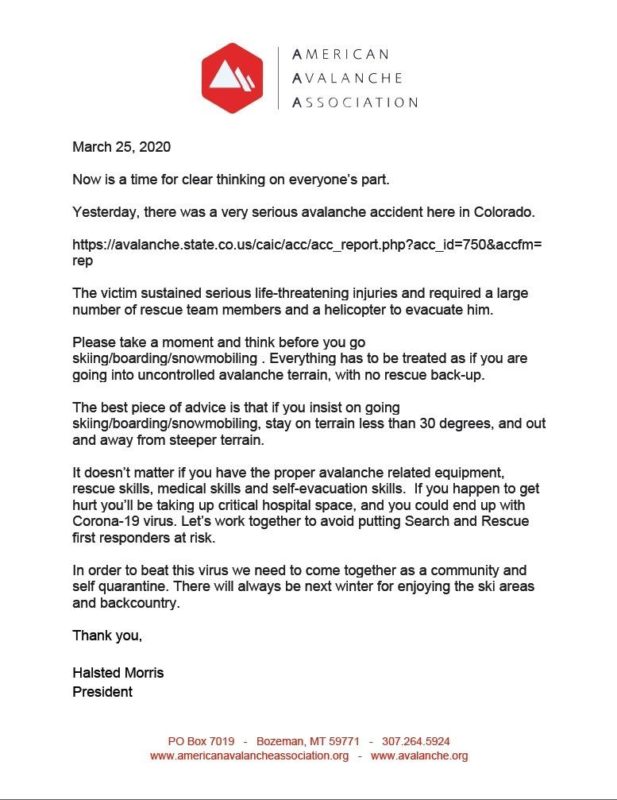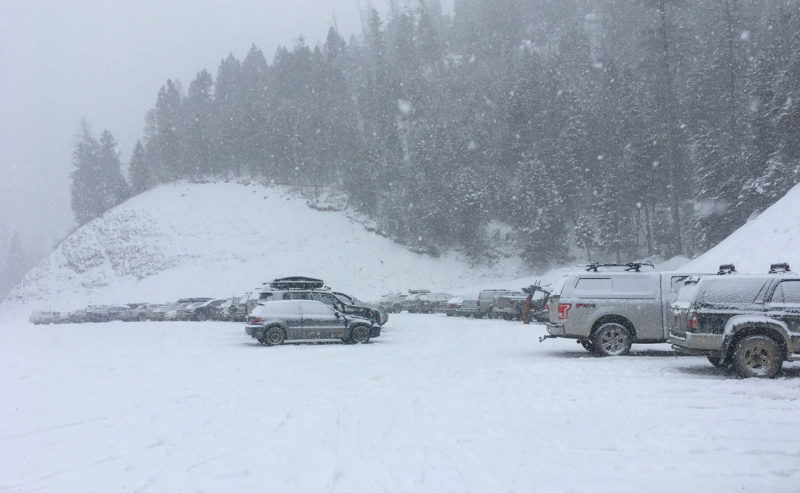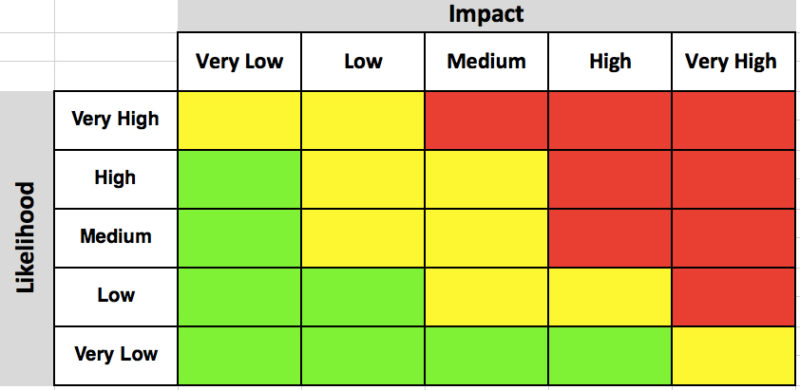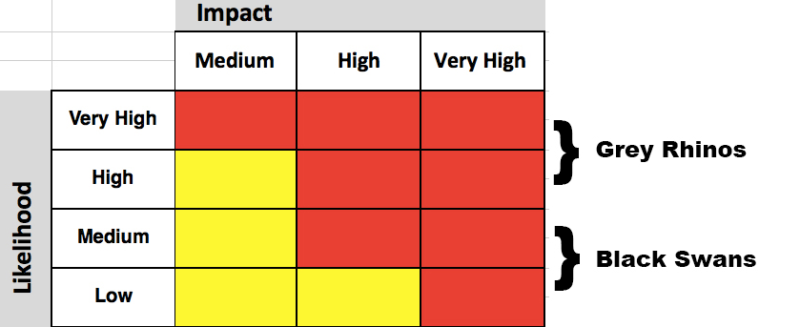It isn’t hyperbole to assert that the current COVID19 world health crisis is profoundly affecting every single one of us. For some, there are worries about losing family members or friends with underlying health issues, others face challenging household-level economic uncertainties. It is a tough time all around, and believing that everyone is getting through this as best they can helps the world seem a little less dark. Adding insult to injury, having the “joie de vivre” of why we live where we live, and our physical outlets diminished (or even possibly snatched away) makes this difficult time seem even bleaker.
This post is not to judge any members of our community or to tell anyone how best to weather this. Our advice in that regard is – be kind to those close to you, and also to yourself. This post’s purpose is to convey some information from the greater community of Avalanche Professionals writ large, clearly state our current guidance on heading out into the backcountry, to pass along some observations we’ve been getting from folks in our advisory area, and to share some thoughts about risk management.
The American Avalanche Association sent the following letter on March 25th.

This letter is in synch with the public messaging we are currently passing along. To be clear, that message is: Right now, the safest thing for you, your community, and your loved ones is to forgo backcountry skiing and riding.
We’re not idiots, so we know that many of you are still enjoying skiing and riding the backcountry. The image below shows a photo of Lot 2 at Montana Snowbowl from April 1st that accompanied Nick Mott’s MTPR piece exploring the “to-go or not” conundrum on April 2nd. https://www.mtpr.org/post/headed-out-keep-your-distance-and-minimize-your-risks

Clearly, there are a lot of people still looking for and likely finding the solace and exhilaration experienced during a day traveling in the mountains. Since March 15th Backcountry skiing “is experiencing what could be the biggest bump in users ever” You Probably Shouldn’t Be Backcountry Skiing Right Now – Outside Magazine. We luckily live in a society where people’s individual appetite for risk can dictate their behavior.
Right now, an over-exuberant individual risk tolerance, inexperience, or even a small error in judgment, can put a real strain on a healthcare system that is bracing for its greatest challenge in several generations. We get it, the existential balm of powder snow and vigorous exercise has a powerful appeal to all of us right now. Unfortunately, the possibility of knock on effects to yourself and others is just too high to justify that risk.
We have gleaned several reports over the last several days about snowpack instabilities and sizable skier triggered avalanches in the Bitterroots. We rely on receiving this information to help people gauge risk, and we are not interested in any “Monday morning quarterbacking” of individual decisions that can blossom on social media. If you go out and see or experience any of the “5 Red Flags” please let us know. You could save a life, and you can post your observations anonymously.
The weather is forecasted to warm up vigorously heading into the weekend. Any time there is a rapid shift with warming weather that increases concerns about the stability of the snowpack. While the regularly scheduled avalanche forecast has wrapped up for the season, we will continue to get public observation information out to the public as we get them. You can find these observations here.
The recent increase in backcountry skiing and riding has already had real consequences. Outside of Jackson Hole on Taylor Mountain off Teton Pass, there was a fatality and body recovery on April 1rst and 2nd. You can read the accident report here. http://www.jhavalanche.org/eventDetail/event/39526
On April 3rd, 46-year-old Robert Kincaid died in an avalanche northeast of the Sheep Creek area in Bonneville County, Idaho. Many members of the snowmobile community regard Robert as a legendary rider. https://www.eastidahonews.com/2020/04/popular-snowmobiler-killed-in-avalanche-being-remembered-as-a-legend-in-the-sport/
On March 24th there was an accident and a successful rescue of a snowboarder near the town of Ophir Colorado that took 40 volunteers. https://snowbrains.com/40-rescuers-attended-to-seriously-injured-snowboarder-caught-in-avalanche-near-telluride-co/
A quote from the incident commander in Colorado follows -Sheriff Bill Masters wants to remind people of the dangers of the backcountry “especially in light of COVID-19 when our local resources are stretched and incidents like this stretch them even more. People need to use their friggin heads.”
To help visualize the current risk environment right now, we’d like to share two images.
At baseline, the risk landscape matrix generally looks something like this: (note: higher avalanche danger typically shifts the red zone towards the median as it increases. Also different avalanche problems can shift this table in a variety of ways)

If you believe that you can eliminate all risks from traveling in the backcountry, you are mistaken. There is an element of inherent risk in doing anything, and this especially relates to backcountry skiing or riding.
Even if you:
1. Go out with experienced partners in peak physical condition
2. Everyone has recently had formal avalanche education
2. Have partners who communicate honestly and effectively
3. Everyone has perfectly functioning equipment that they are intimately knowledgeable about and rigorously trained up on
4. Everyone is armed with the best route, weather, and snowpack information you can get.
5. Follow the 10 Commandments of Low Risk Travel
There will almost always be some sort of avalanche problem(s) to be on the lookout for.
These problems are what Bruce Tremper calls the “avalanche dragon waiting beneath the façade of fresh powder”.
This avalanche dragon is also known by two other names: Black Swans and Grey Rhinos.

COVID 19 has taken away all the low impacts of an avalanche accident and has left us with this new risk landscape shown above.
Grey Rhinos are (or more accurately were) a relatively common sight on the savannah. If you are spending time out in consequential terrain when the avalanche risk is elevated you are traveling in Grey Rhino territory. While you may not see one today, you will likely get to see one up close at some point if you don’t mitigate your risk and spend more time in the zone where the likelihood of an avalanche is much lower.
Black Swans are trickier, they can be the deeply buried persistent weak layers we saw this winter, but they are also the anomalies, flukes, or the momentary lapses in judgment or communication that can shift the risk landscape into the danger zone. Black Swans are much more uncommon than Grey Rhinos, but they do exist; and they have killed excellent skiers who are more experienced, and better equipped than you.
If anyone tells you Covid19 was a “Black Swan Event,” feel free to correct them and tell them that “actually it was a Grey Rhino.” The unfortunate truth is that something akin to this current worldwide emergency scenario has been on a lot of smart people’s radar for some time.
One final note:
Backcountry skiing, like many outdoor sports, is generally not the right cup of tea for people who like to take the easiest route to get their recreation. This is part of what makes the community vibrant, opinionated, and somewhat iconoclastic. It is important to consider that when the general public is stretched to their breaking point with stress and uncertainty, we as a community run the risk of experiencing blowback from a tragedy.
Usually as a community, we suffer these losses alongside people who understand what it is about what we do that makes these risk equations even remotely worthwhile. During these challenging times, the gut churning platitudes of “at least they died doing what they love” will not be in order at a funeral or wake that cannot even take place for the foreseeable future. Frankly, we are 100% fine with never hearing that phrase uttered again. Public blowback could easily be out of sync with what we expect, or feel is warranted.
There is no doubt that social media has exacerbated the descent of the tenor of public discourse into the proverbial sewer. If we are seen as being blasé to the situations most folks are living through, we can easily be painted as selfish, not doing our part, or even hurting the collective effort to “just get through this.” Another accident or fatality in short order over the next week or two may constitute a trend for the general public and media, and that could widely paint backcountry skiing in a very negative light. Be aware that this this scenario is already happening.
It is worth considering that this could have consequences we cannot foresee in terms of access and resources. Please know that in most instances across the United States Avalanche Center funding is tenuous at best, and there are certain cases where it is downright negligent. As an Avalanche Center tasked with a public safety mission, we feel it is our job not just to accurately explain and highlight risks during winter storm cycles but also during extraordinary times like these. We are living through interesting and challenging times, so please try to be extra patient and good to one another. And let’s all “use our heads.”
Thanks for your time and attention.
Sincerely,

The West Central Montana Avalanche Center and Foundation













